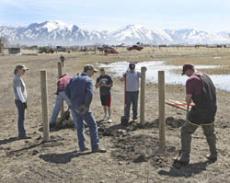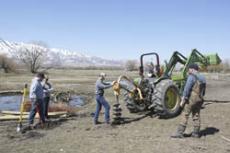Students volunteer to help restore wetland
Students volunteered time Saturday to help restore local property owned by Ann and John Ribera into wetlands, a project that will take many years to complete.
The Riberas are a retired military couple who have seen the world, Ann Ribera said, and were struck by the beauty of Cache Valley and Spring Creek. Over the last seven years, a combination of drought and noxious weeds destroyed their wetland property, she said, and now she and her husband have started this project to restore the land to its former state.
“‘If you want to change the world, you start with your backyard,’ my mom said,” Ribera said. “We want to make it a neat place for Boy Scout troops, school classes or anyone who wants to come. I have 11 grandchildren and I’d love to leave a legacy for them.”
Trent Staheli, junior in range science and vice president of the USU Range Club, said six USU Range Club students came to volunteer Saturday. Ribera said Saturday’s volunteers put up half of the living fence that will surround the wetlands when the project is complete.
Ribera said the couple will apply for a conservation easement, which means the government will designate the land as protected wetlands and prohibit any other use of the property.
“It’ll be this little oasis in Cache Valley that will always be protected,” Ribera said. “So our birds, and geese, and ducks will have a permanent home, hopefully. They won’t have to go to the golf course anymore.”
Robert Johnson works for a locally based land management and environment consulting firm called Providia Management Group, LLC and will be a graduate student in the College of Natural Resources this fall. He said he is working with the Ribera’s on the project and has helped them get through the paperwork required by the government. The project is getting local and national attention, Johnson said, which he hopes will spark interest for more groups to create similar projects, as well as encourage volunteer involvement.
“They’re pretty rare, this couple,” Johnson said. “It takes a rare breed to be able to persevere in the long process it takes to get approval and then somehow find money to get it done. They want to be a model for anyone who wants to do this in the future.”
The restored wetlands’ consistent water and vegetation will provide habitat for about 10 different bird species, such as bald eagles and cranes, Johnson said. There are many other reasons for restoring the property, Johnson said, besides providing animal habitat and beautifying the land.
“It’s in a small scale, but water will flow from Spring Creek to the wetland, and wetlands are a natural water purifier,” Johnson said. “It will help clean Spring Creek, which has been labeled unclean water with its chemicals.”
Johnson said he hopes USU students will take advantage of this property as a learning tool.
“This is a project the natural resource college could adopt as their own,” Johnson said. “Student organizations or students doing research can use this project as a volunteer effort or a place to do their research.”
Beyond being useful as an educational tool, Johnson said the project could provide invaluable and free experience for students planning to go into environmental conservation.
“We’re actually doing something positive for the environment,” Johnson said. “It applies to every aspect of the environmental field. We’re dealing with water rights, how to get money for this, etc. USU students can learn from it, and it can be fun in the process.”
Ribera said students who would like to get involved will have plenty of opportunities. There will be several volunteer days during this summer and fall, she said, and most of the volunteer work this year will involve planting. Anyone who would like to get involved with the project can contact Ann and John Ribera at (435) 754-7184.
“We love any and all people to come on by,” she said. “And we always provide lunch.”
-rac.ch@aggiemail.usu.edu

VOLUNTEERS WORKED SATURDAY to help a local couple restore property into a wetland. (Cameron Peterson)

